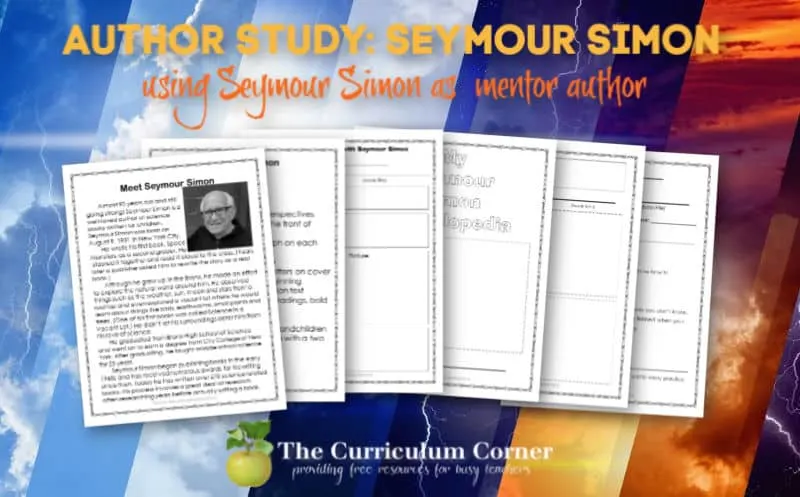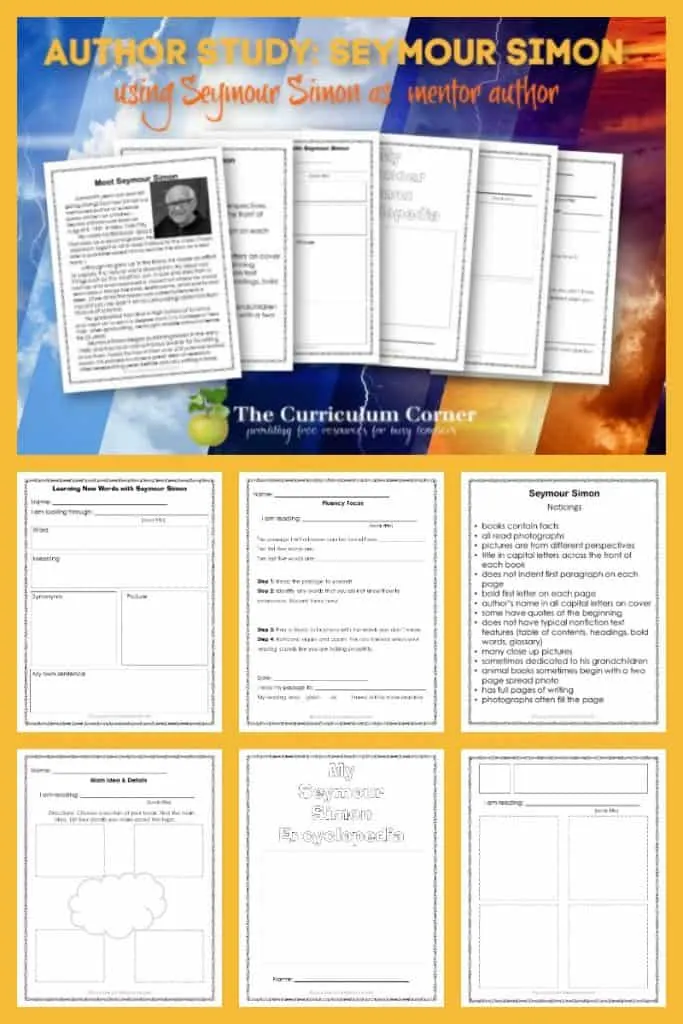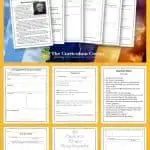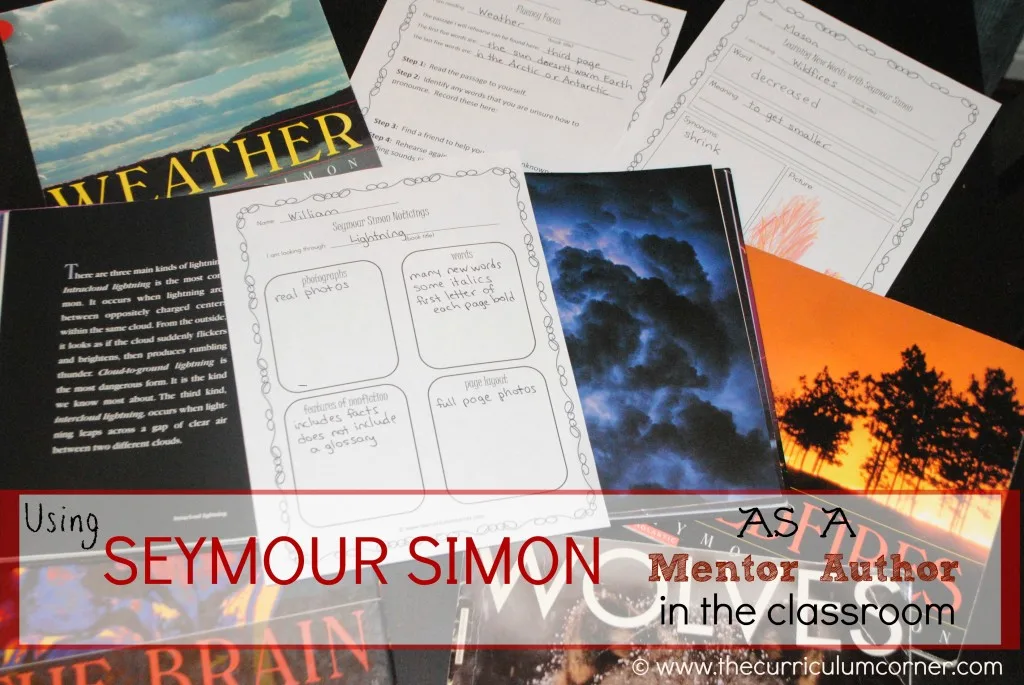Author Study: Meet Seymour Simon

This is another free resource for teachers from The Curriculum Corner.
Add this author study on Seymour Simon to your collection of writing workshop mentor author resources.
One of our very favorite authors for older students is Seymour Simon.
His photographs and words grab the attention of children and make them want to learn more about a subject. We believe that he is an author that makes for a great author study.
His works as mentor texts help children find new ways to write nonfiction and help them love the reading of informational text.
You may choose to use all of the resources we have created for your study or pick the ones that fit your classroom.
Our Seymour Simon Author Study includes the following resources:
Biography Written to help students learn about the life of Seymour Simon, students will discover interesting facts about Simon becoming the author he is today.
Character Traits You might choose to focus on the character traits of Seymour Simon with this graphic organizer. Want to focus more on character traits: try our Character Traits Collection.
Noticings
If you have never begun a writing unit of study with noticings, we highly recommend it. The idea is that children are given a stack of books that fit the theme.
In this case, you would supply students with a range of books by Seymour Simon. Students go through the books to see what they “notice” about Simon’s writing style. You might choose to use our recording sheet:.
Or, students can simply use post-it notes to mark spots in the book that stand out. It is important to encourage children to focus on the style and not the words. It can be very difficult for children to begin to look deeper in to the writing and not report facts.
This skill takes a great deal of practice so be patient when you first introduce the idea. If it is your first time asking your students to do noticings, you might share a book aloud and work through the ideas together and then allow students to explore further in small groups.
Our sample anchor chart is ready to print and can be used as a resource in your room.
However, we find that it is important to ask children to notice without giving them the answers.
You might choose to use this as your guide and create an anchor chart using your students’ ideas.
If children need prompting to begin, encourage them to think about: What does SS do to engage the reader? Photographs (angles, perspectives, close ups); Writing style? Doesn’t have typical nonfiction text features (Table of Contents, Chapter titles, Glossaries, Bibliographies, etc). He says that he writes “stories” for children that happen to be nonfiction. He doesn’t write textbooks or encyclopedias…he tells stories. It is a choice in his writing style.

Working with Word Choice
Word Map Seymour Simon books are full of new words for readers.
This is a great opportunity to help children explore vocabulary! To introduce, we suggest completing two or three word maps as a class. Each word map guides students through multiple steps that will help them develop an understanding of the word.
Once students understand the task, students can choose a word and make their own dictionary or teacher can choose words for students to work on at a center.
Wondrous Words Seymour Simon weaves beautiful language into his nonfiction writing.
Encourage your students to find the unique and descriptive words he uses. Ask them to record the words they encounter in this Wondrous Words booklet.
You might create it as a simple book with lines are use the categories we provided.
Either way, the idea is to help your students develop a resource for their writing.
Reading & Understanding Informational Text
Encyclopedia Seymour Simon writes about a variety of high interest topics. You can have students create their own encyclopedia with what they learn as they explore his books.
This can even be done during a literacy center. Print the cover and students can add as many encyclopedia pages as they need. The box on the top left is for the letter the topic starts with and to the right, have students record the topic.
When students have completed their pages, they can alphabetize and staple. This could be used as a resource for facts when students are writing.
Main Ideas & Details Work on finding the main idea and details within paragraphs. This organizer has a cloud in the middle for the main idea and four boxes surrounding for students to record the details.
Fluency Focus Fluency is a skill that even strong readers need help with.
Using this paper, students identify their book and passage for fluency practice. Then follow the steps for getting ready to read a passage aloud. At the bottom students read aloud to another and circle great, ok or needs more practice. It is important to note that the idea behind fluency practice is not for students to be put on the spot and asked to read aloud without practicing.
Fluency practice is meant to be rehearsed. Students should have exposure to the text and many opportunities to practice.
They are striving to make their reading smoother when reading aloud and the goal is that this will transfer to their independent reading.
Becoming an Author
After studying the writing of Seymour Simon, the goal is for students to use what they have learned to practice writing like an author.
As a class, we suggest brainstorming topics that students can research and learn more about. You might choose to create a class book or students might write individual books. These resources will help you get started:
Finding a Topic Have students brainstorm ideas for their topic. You might begin by creating a class web with all of the ideas your students can think of. Then, students can narrow down their topic to their top four choices. Remember, students who have choice in their topic are going to be more motivated to write! We do not suggest choosing topics for your students.
Planning This book will require research which can be done by students reading books and completing internet searches. They will need to complete graphic organizers as they collect their research. Check out some of our other resources below to help with this portion.
You can download our Seymour Simon collection here:
Try these resources:
Be sure to look at www.seymoursimon.com. This web site has resources for teachers and children! It’s a great place to encourage your children to explore.
Add some of your favorites to your collection (contains affiliate links):
Photography Tips An important aspect of Seymour Simon books is the photography. Instead of having students illustrate the books they create, allow them to use real photographs this time.
They can find photos online but how great would it be for students to take their own photos for this project? We have found a couple of websites with some photography tips for your students:



Seymour Simon
Tuesday 10th of February 2015
Excellent information! Thank you ,